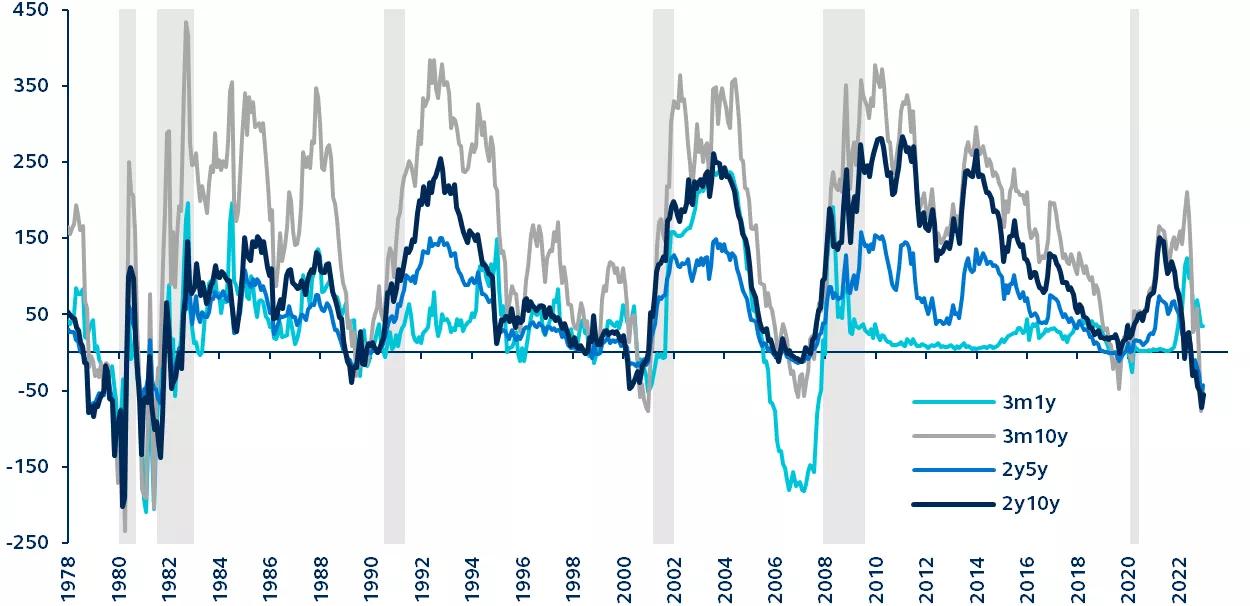Several characteristics of the U.S. Treasury yield curve highlight the heightened risks to the economic outlook in 2023. With the 2y10y yield curve at its most inverted point since the 1980s, and the U.S. Federal Reserve determined to further tighten monetary policy, recession is creeping ever closer.

U.S. Treasury yield term spreads and economic recessions
Basis points, recessions are shaded, 1978–present

Federal Reserve, Bloomberg, Principal Asset Management. Data as of December 31, 2022.
While economic resilience last year has led some to believe the U.S. will avoid recession in 2023, key market indicators say otherwise. Yield curve inversion, when shorter-term Treasury maturities begin yielding more than longer dated issues, has occurred ahead of every U.S. recession since the 1950s—and today, nearly every yield term spread has inverted. While not every instance of inversion has led to a recession, several features of the current yield curve are sending a very strong recession signal:
- Deeper inversions are a more telling indicator than shallow inversions. The 2y10y curve is its most inverted since the early 1980s.
- Similarly, a sustained inversion gives a stronger signal of impending recession than a brief inversion. The 2y10y curve has been inverted since early July.
- The lead time between 2y10y inversion and recession tends to be long and variable, sometimes extending to four years. Today, however, other segments of the yield curve which are typically consistent with high recession risk within a 12-month period, including the 3-month/1-year and 3-month/10-year curves, are also inverted.
Starting 2023, many investors have been reassured by the strength of the U.S. labor market. Yet, as yield curve inversion is demonstrating, the Federal Reserve is determined to tighten monetary policy until that strength is eradicated—the recession clock is ticking.
Investing involves risk, including possible loss of principal. Past performance is no guarantee of future results and should not be relied upon to make an investment decision.
The information presented has been derived from sources believed to be accurate; however, we do not independently verify or guarantee its accuracy or validity. Any reference to a specific investment or security does not constitute a recommendation to buy, sell, or hold such investment or security, and does not take account of any investor’s investment objectives or financial situation and should not be construed as specific investment advice, a recommendation, or be relied on in any way as a guarantee, promise, forecast or prediction of future events regarding an investment or the markets in general. The opinions and predictions expressed are subject to change without prior notice.
Principal Funds, Inc. is distributed by Principal Funds Distributor, Inc.
Principal Asset Management leads global asset management at Principal.®
For Public Distribution in the U.S. For Institutional, Professional, Qualified and/or Wholesale Investor Use only in other permitted jurisdictions as defined by local laws and regulations.
© 2023, Principal Financial Services, Inc. Principal Asset ManagementSM is a trade name of Principal Global Investors, LLC. Principal®, Principal Financial Group®, Principal Asset Management, and Principal and the logomark design are registered trademarks and service marks of Principal Financial Services, Inc., a Principal Financial Group company, in various countries around the world and may be used only with the permission of Principal Financial Services, Inc.
2665766